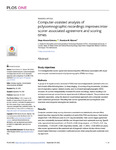Mostrar o rexistro simple do ítem
Computer-assisted analysis of polysomnographic recordings improves interscorer associated agreement and scoring times
| dc.contributor.author | Alvarez-Estevez, Diego | |
| dc.contributor.author | Rijsman, Roselyne M. | |
| dc.date.accessioned | 2023-01-02T11:28:14Z | |
| dc.date.available | 2023-01-02T11:28:14Z | |
| dc.date.issued | 2022-09 | |
| dc.identifier.citation | Álvarez-Estévez D, Rijsman RM (2022) Computer-assisted analysis of polysomnographic recordings improves inter-scorer associated agreement and scoring times. PLoS ONE 17(9): e0275530. https://doi.org/10.1371/journal.pone.0275530 | es_ES |
| dc.identifier.uri | http://hdl.handle.net/2183/32279 | |
| dc.description | Estudo iniciado no Haaglanden Medisch Centrum cunha política de coste neutral baixo o número de proxecto 2019-073. | es_ES |
| dc.description.abstract | [Abstract]: Study objectives To investigate inter-scorer agreement and scoring time differences associated with visual and computer-assisted analysis of polysomnographic (PSG) recordings. Methods A group of 12 expert scorers reviewed 5 PSGs that were independently selected in the context of each of the following tasks: (i) sleep staging, (ii) scoring of leg movements, (iii) detection of respiratory (apneic-related) events, and (iv) of electroencephalographic (EEG) arousals. All scorers independently reviewed the same recordings, hence resulting in 20 scoring exercises per scorer from an equal amount of different subjects. The procedure was repeated, separately, using the classical visual manual approach and a computer-assisted (semi-automatic) procedure. Resulting inter-scorer agreement and scoring times were examined and compared among the two methods. Results Computer-assisted sleep scoring showed a consistent and statistically relevant effect toward less time required for the completion of each of the PSG scoring tasks. Gain factors ranged from 1.26 (EEG arousals) to 2.41 (leg movements). Inter-scorer kappa agreement was also consistently increased with the use of supervised semi-automatic scoring. Specifically, agreement increased from = 0.76 to K = 0.80 (sleep stages), = 0.72 to K = 0.91 (leg movements), = 0.55 to K = 0.66 (respiratory events), and = 0.58 to = 0.65 (EEG arousals). Inter-scorer agreement on the examined set of diagnostic indices did also show a trend toward higher Interclass Correlation Coefficient scores when using the semi-automatic scoring approach. Conclusions Computer-assisted analysis can improve inter-scorer agreement and scoring times associated with the review of PSG studies resulting in higher efficiency and overall quality in the diagnosis sleep disorders. © 2022 Alvarez-Estevez, Rijsman. This is an open access article distributed under the terms of the Creative Commons Attribution License, which permits unrestricted use, distribution, and reproduction in any medium, provided the original author and source are credited. | es_ES |
| dc.description.sponsorship | Xunta de Galicia;ED431H 2020/10 | es_ES |
| dc.description.sponsorship | Xunta de Galicia; ED431G 2019/01 | es_ES |
| dc.language.iso | eng | es_ES |
| dc.publisher | Public Library of Science | es_ES |
| dc.relation.uri | https://doi.org/10.1371/journal.pone.0275530 | es_ES |
| dc.rights | Atribución 4.0 Internacional (CC BY 4.0) | es_ES |
| dc.rights.uri | http://creativecommons.org/licenses/by/3.0/es/ | * |
| dc.subject | Arousal | es_ES |
| dc.subject | Computers | es_ES |
| dc.subject | Electroencephalography | es_ES |
| dc.subject | Humans | es_ES |
| dc.subject | Polysomnography | es_ES |
| dc.subject | Sleep Stages | es_ES |
| dc.title | Computer-assisted analysis of polysomnographic recordings improves interscorer associated agreement and scoring times | es_ES |
| dc.type | info:eu-repo/semantics/article | es_ES |
| dc.rights.access | info:eu-repo/semantics/openAccess | es_ES |
| UDC.journalTitle | PLoS ONE | es_ES |
| UDC.volume | 17 | es_ES |
| UDC.issue | e0275530 | es_ES |
| dc.identifier.doi | 10.1371/journal.pone.0275530 |
Ficheiros no ítem
Este ítem aparece na(s) seguinte(s) colección(s)
-
GI-LIDIA - Artigos [65]






